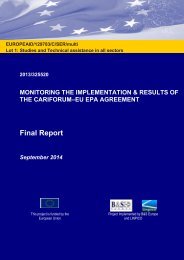A GROWTH-INDUCEMENT STRATEGY FOR JAMAICA IN THE SHORT AND MEDIUM TERM
A GROWTH-INDUCEMENT STRATEGY FOR JAMAICA IN THE SHORT AND MEDIUM TERM
A GROWTH-INDUCEMENT STRATEGY FOR JAMAICA IN THE SHORT AND MEDIUM TERM
Create successful ePaper yourself
Turn your PDF publications into a flip-book with our unique Google optimized e-Paper software.
Acknowledgements<br />
In the fall of 2010 the Jamaican economy registered its twelfth consecutive quarter of<br />
economic decline and was in need of a targeted programme to induce its recovery and<br />
growth. The Planning Institute of Jamaica (PIOJ) was charged with developing this<br />
programme within the framework of the twenty-seven-months Stand-By-Agreement<br />
(SBA) the Country had entered into with the International Monetary Fund (IMF) in<br />
February of that year.<br />
The performance of the economy had been generally poor for decades, and it was clear<br />
from the outset that any proposed programme would have to be designed with an<br />
understanding and sensibility that reached beyond the “wisdom” of conventional thinking<br />
and approaches. Accordingly, the paradigm used by the PIOJ for the Growth Inducement<br />
Strategy (GIS) for Jamaica presented in this study combines traditional scholarship with<br />
public scholarship. Public scholarship is defined in our study as collaborative<br />
knowledge-making with, about and for various publics and communities. It was utilised<br />
because it grounds traditional academic scholarship in societal issues germane to<br />
Jamaica’s current reality, such as justice, equity, democratic inclusiveness and<br />
community empowerment, thereby ensuring their influential role in public policy.<br />
Together, both forms of scholarship served to achieve a comprehensive and systematic<br />
understanding of the constraints to, and the opportunities for, economic growth and<br />
development of the Jamaican economy.<br />
This study was carried out in the Growth Secretariat of the PIOJ, headed by Mr. Everton<br />
Mcfarlane, Deputy Director General, and reflects collaboration between the departments<br />
of the PIOJ, and consultations with a large number of persons in other Ministries,<br />
Departments and Agencies (MDA) of the Government of Jamaica, and colleagues<br />
representing community, private sector and civil society groups. The project was led by<br />
the Director General, Dr. Gladstone Hutchinson, and the lead consultant for the project<br />
was economic growth expert Dr. Donald J. Harris, Professor Emeritus of Economics,<br />
Stanford University.<br />
The project benefited significantly from the unstinting energy and organizing and<br />
coordinating skills of Mrs. Rosemarie Broadbell, Chief Technical Assistant in the<br />
Director General’s Secretariat, and from the technical and intellectual insights of PIOJ<br />
colleagues including, inter alia, Mrs. Claire Bernard, Mrs. Marcia Blake-Hall, Mr. Joseph<br />
Cox, Mr. Richard Lumdsen, Ms. Barbara Scott, Mr. James Stewart and Mr. Easton<br />
Williams. Sincere gratitude is also acknowledged to the Jamaica Competitiveness<br />
Enhancement Programme, funded through a grant from the Inter-American Development<br />
Bank (IDB), for providing both technical and financial support that made this project<br />
possible.<br />
Lastly, because public scholarship was a critical component of the study paradigm, the<br />
PIOJ expresses gratitude to persons from MDA, community and civil society groups, and<br />
viii






